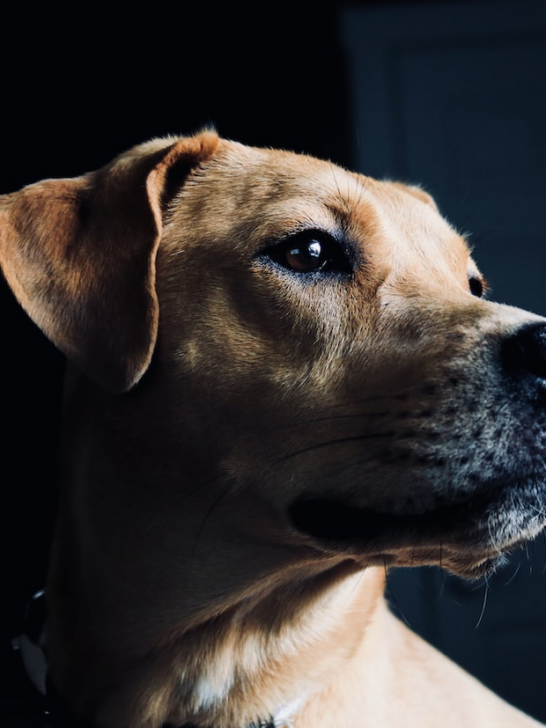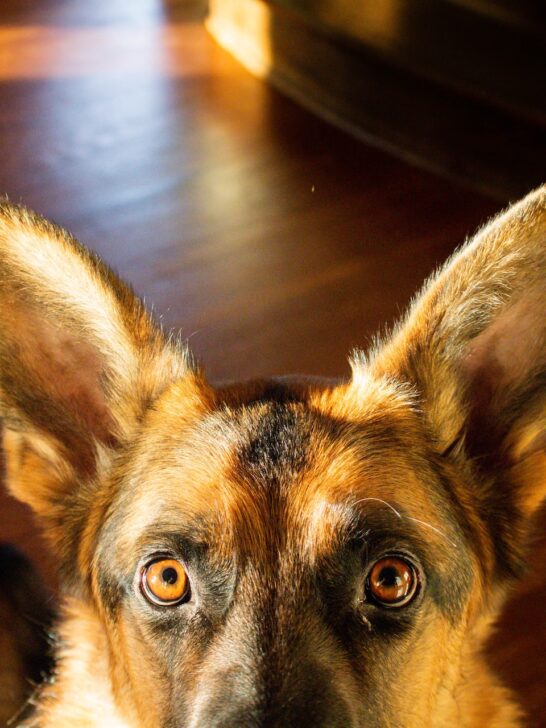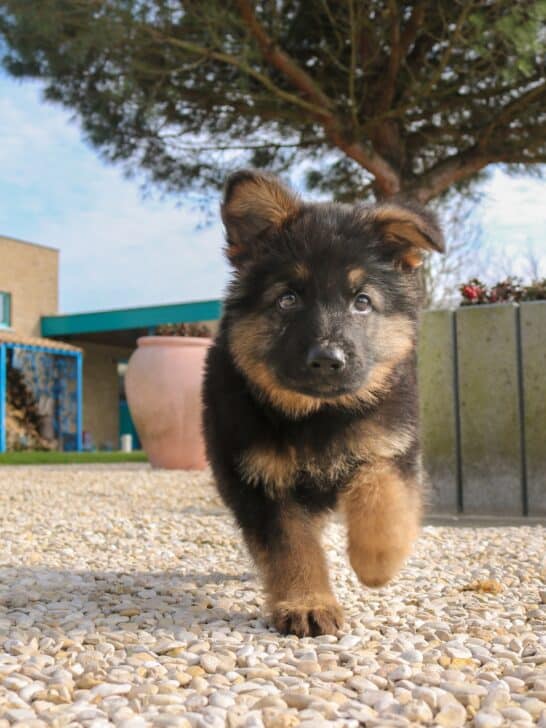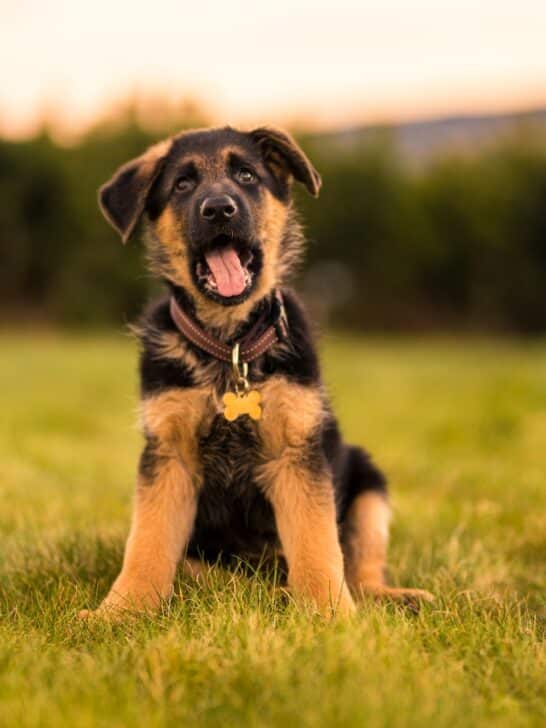How to Discipline a German Shepherd Puppy: Effective Training Guide
German Shepherd dogs are one of those dog breeds that are quite simply iconic.
From their many wonderful roles in film and television to their reputation as fearless guard and protection dogs in real life, most people can recognize and name the German Shepherd dog breed on sight.
But even though expert German Shepherd breeders, trainers, and owners can make disciplining a German Shepherd puppy look easy, it is anything but.
In this article, we go into depth to explain what it takes to effectively discipline a German Shepherd puppy.
You want to discipline your German Shepherd puppy the right way right from the beginning because how you handle disciplinary needs will shape your relationship with your dog over the entire time you are together.

How to Discipline a German Shepherd Puppy
German Shepherds are a large dog breed, which means puppyhood often lasts longer than it will for smaller and toy size breed dogs.
This can make training and disciplining a German Shepherd puppy more challenging.
Puppyhood is a time of intense physical, hormonal, and mental changes that can bring some unpredictable behaviors.
However, the German Shepherd is a highly intelligent and sensitive dog, and with consistent, positive, daily training, you can effectively discipline your puppy so they grow up into a happy, healthy, well-behaved, and well-trained adult dog.
Classical Versus Operant Conditioning in Modern Canine Training
There are two main training methods at work in nearly all modern canine training programs, whether positive or negative (more on this here shortly).
As Very Well Mind explains, these two training methods are both grounded in human and animal psychology and are called “classical conditioning” and “operant conditioning.”
Classical conditioning in dog training
Classical training came first in terms of developing intellectual models for training animals.
The entire concept of the canine training methods we use most today first arose with a researcher you probably learned about in school – Ivan Pavlov.
Pavlov became quite famous (and still is) for his experiment getting dogs to salivate when hearing a bell.
There are two concepts to remember here:
- The bell is the learning tool – the “conditioning.”
- The salivation is the response desired – the “outcome.”
Salivation is considered an “involuntary response” – as in, it is a behavior dogs do naturally.
Dogs will naturally start to salivate whenever they see something that looks tasty that they want to eat (they are just like people this way!).
What made classical conditioning ground-breaking was that Pavlov was able to get the dogs to start salivating by pairing the sound of the bell with the presentation of food.
After a time, the association in the dogs’ minds with the bell and the food became so strong that Pavlov could ring the bell and the dogs would start salivating before they even saw food – and even if the food never appeared.
Today in psychology circles, Pavlov’s training method is now called “classical conditioning.”
Here, the term “classical” simply means “classic” – the method upon which all further research is based.
The term “conditioning” simply means “learning.
So from here forward, when you hear the word “conditioning” used about dog training, you can just substitute it with the word “learning” in your mind.
Conditioning a dog is simply teaching a dog, regardless of what specific training method you choose to employ.
Operant conditioning in dog training
Operant conditioning builds on Pavlov’s work.
A researcher named B.F. Skinner is the founder of operant conditioning as a training method.
A researcher named Edward Thorndike created the “law of effect” that led to the discovery of operant conditioning.
Operant conditioning is quite similar to classical conditioning except for one important change – the behavior being trained is voluntary (learned) rather than involuntary (naturally-occurring).
With operant conditioning you are using a reinforcer – rewards or punishment – for teaching your German Shepherd a new behavior rather than teaching a new association (such as the sound of a bell) with existing behavior.
Alternately, you are teaching your dog not to do a learned behavior, such as inappropriate elimination in the house or barking constantly.
You will always be working both with classical and operant conditioning as your discipline and train your German Shepherd puppy.
This is because your goal is to better understand how your dog is wired and what is the most motivational way to encourage the behavior you want and discourage behavior you don’t want.
So you will always be working both with natural (involuntary) canine responses and trained (learned or voluntary) responses.
For example, you will work with natural behaviors such as salivation, barking, tail wagging, prey drives, scent tracking, jumping, eliminating, etc., training more of what you want and less of what you don’t.
And you will work with learned (voluntary) behaviors that you can train your dog to do, such as learning tricks, distinguishing between threats and friends, going into a crate, etc.
Again, training more of what you want and less of what you don’t.
This is where the type of reinforcer you choose – rewards or punishment – becomes so critically important to success with disciplining a German Shepherd puppy.
Now that you have a basic understanding of the differences and similarities between classical and operant conditioning in dog training and how each works, let’s talk more about positive versus negative discipline for your German Shepherd puppy.

Positive Versus Negative Discipline for a German Shepherd Puppy
If you are new to dog ownership and dog training, you may be a little confused over what is meant by “positive” versus “negative” dog training.
What is the difference?
As Psychology Today explains, it would be just as easy to talk about “reward-based” versus “discipline-based” dog training.
Noted canine expert and author Dr. Stanley Coren highlights that one is based on rewards (positive discipline) and one is based on punishment (negative discipline).
In either case, you may get the response you desire. But you may find your dog is much changed based on which method you select.
Let’s look at some examples of positive discipline versus negative discipline so you can start to wrap your head around the differences.
Positive discipline examples
Some of the easiest examples of positive dog training or positive discipline include these:
- Treats.
- Pats.
- Toys.
- Playtime.
- Praise.
The goal of positive or rewards-based discipline is to associate good behavior with good things.
Negative discipline examples
Some of the most commonly used negative dog training or negative discipline methods include these:
- Scolding.
- Slaps or hits.
- Shock collar.
- Leash jerking.
- Rubbing face in dog pee or poop.
The goal of negative or punishment-based discipline is to associate bad behavior with bad things.
So now that you have a better idea of the main differences between positive and negative or rewards versus punishment discipline methods, let’s talk directly about how to use these methods on a German Shepherd puppy to achieve your goals.

Understanding the German Shepherd Dog Intelligence Type
German Shepherds are highly intelligent dogs.
As Science Alert reports, according to a survey of 199 expert canine trainers, the German Shepherd is ranked third out of 79 purebred dog breeds in terms of overall intelligence and trainability!
This means your German Shepherd puppy is very, very intelligent. It also means your puppy is very trainable.
Of course, just like there are different types of people intelligence, there are different types of dog intelligence.
The specific type of intelligence that is measured in this survey is “working intelligence,” which is a type of intelligence associated with quickly learning new commands and repeating them reliably on cue.
So your German Shepherd puppy is technically able to learn a new desirable behavior (or unlearn an undesirable behavior) in as little as five tries and remember what they have learned with 95 percent accuracy.
This is exactly why German Shepherds are the second most popular purebred dog breed in the United States (out of 195 purebred dog breeds) according to the American Kennel Club (AKC).
These dogs are just smart, smart, smart! They are highly tuned into their people and eager to please.
Whatever training method you choose, you won’t have to work hard to make yourself understood by your dog as long as you are consistent with your cues.
But this also means that your training method of choice will have a lasting impact on your dog right away. So you want to choose wisely.
Which Training Method Works Best to Discipline a German Shepherd Puppy?
Because German Shepherd dogs are “people” dogs – they crave human company and even the company of another dog is not enough – this means they are emotionally sensitive as well as intellectually smart.
When a dog is particularly emotionally sensitive, as most people-centric dog breeds are – any kind of punishment or negativity will have a deep and lasting impact on them.
You can see this in people as well.
While some people just seem to let life roll off their back, more easily letting go of old hurts and mistakes, other people hold onto these memories and can even become traumatized by shame, embarrassment, or hurt.
Your German Shepherd is sensitive like this as well. These dogs want to please and have been carefully bred to have a strong desire to please people.
So any kind of negativity, whether in words or actions, is likely to leave a lasting impact.
This is also why the only training method you want to use for disciplining a German Shepherd puppy is going to be positive reinforcement training.
There is another reason why you don’t want to use negative or punishment-based training for German Shepherd discipline.
German Shepherds are very strong and powerful dogs.
They are used extensively in military and police work, K-9 search and rescue and bomb-sniffing, the Secrete Service and private protection and guard dog work, and similar occupations.
German Shepherds that are not trained with positive methods can sometimes become aggressive.
This is especially the case if there is no underlying positive bond with a person.
A German Shepherd that is subjected to harsh corrections can turn into a dangerous dog. You don’t want to take that risk for yourself or your family.
And there is truly no need to use harsh punishments when you have a dog that is so smart and can easily learn the same desirable behaviors using positive reinforcement.
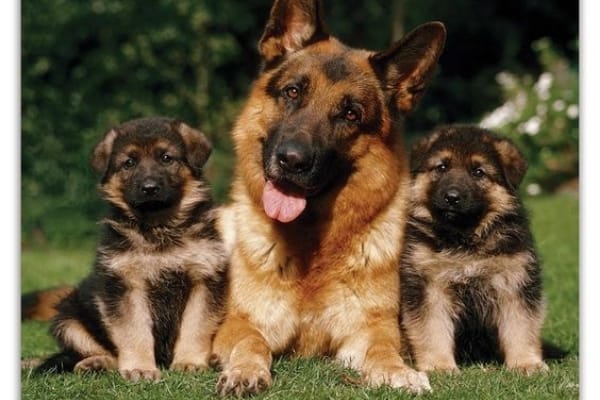
How to Use Positive Reinforcement to Discipline a German Shepherd Puppy
Now you have a firm grounding in how modern canine training works today, your different training options, and why positive reinforcement or reward-based training is the best choice for a smart “quick study” dog breed like the German Shepherd.
How exactly can you use positive training methods to discipline a German Shepherd puppy?
The answer to this question starts with establishing reasonable expectations for any puppy, no matter how smart and attuned to you.
According to the German Shepherd Dog Club of America (GSDCA), your German Shepherd puppy’s first six months of life will set the stage for the rest of your lives together.
You want those first six months to be good ones!
However, puppies will be puppies even if they are exceptionally smart, very bonded to you, and highly motivated to please you.
In other words, puppyhood is a tumultuous time but it is also a relatively short time in your puppy’s life, so your goal should be progressing, not perfection.
Remembering this will also help you not get too frustrated when your puppy seems to temporarily “forget” what they have learned.
Overall, there are always two goals when it comes to disciplining and training a German Shepherd puppy:
1. Encourage desirable behaviors
An example here would be calling your German Shepherd puppy by their name and saying “Come!” and having your puppy walk right to you.
You are pleased with this response and show it with praise, pats, and even a small tasty treat.
Your German Shepherd puppy learns that prompt obedience results in good things – praise, pats, and treats.
2. Discourage (extinguish) undesirable behaviors
An example here would be if you start preparing your German Shepherd puppy’s dinner and they bark and bite at your shoes.
You provide discipline in a positive/neutral way by simply waiting – you do not give the food until your puppy stops barking and biting.
This teaches your German Shepherd puppy that quiet behavior brings the food out more quickly.
See also: Why Does My German Shepherd Circle Me: Understanding This Puzzling GSD Behavior
What Can You Reasonably Expect While Training a German Shepherd Puppy?
Because German Shepherds are bred for a specific type of work, these dogs have some innate tendencies that can be especially misunderstood in puppyhood.
As the German Shepherd Dog Rescue of Sacramento Valley charity explains, German Shepherds were bred to herd and track and guard and work alongside people.
These dogs are high energy naturally. They are “vocal” naturally. They are social and people-focused naturally.
They are workers naturally.
In puppyhood, these very desirable traits can often manifest in initially undesirable ways, such as non-stop barking and whining, jumping, chewing and mouthing, and worst of all – finding a “job” to do if they get bored (such as biting the table legs).
Combine this with the onset of puppyhood teething, when the puppy teeth are calling out and the adult teeth are growing in, and you now have an energetic, you-centric dog that is uncomfortable and irritable.
At the same time, your German Shepherd puppy has a bladder and bowel system that is still developing and so you are trying to potty train your dog to go to the bathroom outside (and only outside) and in a specific place on cue.
But your puppy may have accidents even when they do their best not to, because sometimes their incompletely developed bladder and brain may fail to understand if they need to go right away.
You are likely also trying to crate train your puppy so you can safely leave your dog for longer periods and/or travel safely together.
So your German Shepherd puppy may have some initial anxiety, especially since they are also adjusting to life without their mom and littermates at the same time.
When you add all this change and transition up and factor in that your German Shepherd puppy is also trying to get to know you, learn a new house and new family and learn the commands you are trying to teach, it is a wonder you don’t have more disciplining problems!
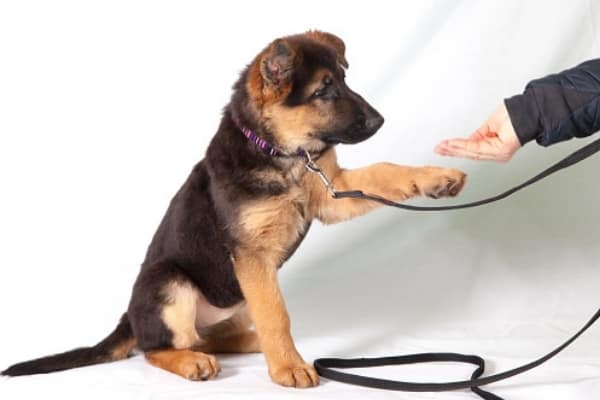
Here are specific tips to minimize frustration for both you and your puppy during training and discipline:
Establish easy verbal cues for every need
If this is your first time training a German Shepherd puppy, you may want to talk to a more experienced dog owner for guidance here.
But in general, you can use commands like “no,” “stop,” “drop it,” “leave it,” “go potty,” “sit,” “stay,” “no bark,” “come” and similar one or two-word commands to start the training process.
Make sure the commands you choose are short and percussive and sound sufficiently different from each other so your German Shepherd puppy will not be likely to get confused.
Address discipline problems right when they happen
Right, when your dog is exhibiting the behavior you don’t want is always the right time to correct it.
Similarly, right when your German Shepherd puppy is doing the behavior you want is the right time to reinforce it.
If the behavior occurred earlier when you weren’t there (such as inappropriate soiling in the house), it is far too late to discipline for it when you finally get home and discover it.
Instead, simply clean up the mess and apply a pet odor neutralizer and begin again.
The neutralizer will discourage your puppy from “scenting” that spot again and assuming it is the potty.
Be sure your puppy’s other basic needs are met
Often, problem behaviors in puppyhood such as barking, biting or mouthing, and soiling in the house are less about your dog’s active desire to misbehave and more about other needs that aren’t getting met.
Discourage problem chewing, for example, by offering your pup an icy teething ring to ease the gum pain.
Discourage jumping up on you or play-growling by taking your puppy for a walk or playing to tire them out and give them a “job” to do.
Discourage inappropriate soiling by taking more frequent potty breaks so your German Shepherd puppy doesn’t have to hold it so long.
Never rule out medical causes for problem puppy behaviors
There are times when you may be trying to discipline a German Shepherd puppy that simply seems to be refusing to “learn.”
For example, continuing to pee or poop in the house well after potty training should be over, or continuing to chew or bite after teething has concluded may well point to bladder/bowel or dental health problems.
If you have tried every disciplinary tactic you can think of and the problem remains, it is always the right time to consider taking your German Shepherd puppy to the canine veterinarian for a “well puppy” checkup – just in case.
With patience, persistence, positivity, and pure kindness, you and your German Shepherd will get through the difficult puppyhood phase and build a closer bond as you do.
Never hesitate to seek out help from a canine behavioral expert or trainer if you run into puppy discipline problems you can’t solve alone.
Watch Expert Trainers With a German Shepherd Dogs
In this amazing short video, you can see the results of using a positive dog training program with a smart and sensitive working dog breed like the German Shepherd dog.
With the right type of consistent, positive training program, there is nothing a German Shepherd will not attempt for their people!

























